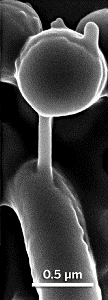Bacteria build nanotube channels to share the innermost contents of their cells with individuals of the same or different species, researchers in Israel have found.
The newly discovered form of bacterial communication may shed light on interspecies collaboration.
 Bacteria build nanotubes to communicate with their own or other species.
Bacteria build nanotubes to communicate with their own or other species.
Forming in just a few minutes, the nanotube highways, which range from 30 to 130 nm in diameter, may help explain how bacteria of many different species coordinate community life in biofilms, says Sigal Ben-Yehuda, a microbiologist at Hebrew University of Jerusalem who led the research. Ben-Yehuda’s team captured images of the nanotube highways with fluorescence and scanning electron microscopy. The researchers also showed that bacteria connected by such channels could share genes and proteins, including those involved in antibiotic resistance.
“Bacteria can use the nanotubes to acquire new features from a neighbor—or maybe kill it,” Ben-Yehuda says. “At this point, we don’t know if there is a gating mechanism in place to control the flow or whether it is an open exchange of cytoplasmic contents,” she adds. The team is working now to narrow down the composition of the nanotube; they have a hint that it involves a membrane because membrane-busting chemical detergents disrupt the channel.
Bacteria are known to communicate by releasing small molecules or vesicles packed with chemical messages. They also construct elaborate protein machines to inject cargo, such as genes, into neighboring cells. But the “intimate interactions” provided by the nanotube channels are “an exciting new discovery,” cell biologists Jeffrey W. Schertzer and Marvin Whiteley of the University of Texas, Austin, write in a commentary about the work.
Certain plant and mammalian cells share their contents with neighbors through microscopic channels known as plasmodesmata and gap junctions, Ben-Yehuda notes. Some mammalian cells also build nanotubes that are analogous to the newly discovered bacterial channels.
Source: http://pubs.acs.org/